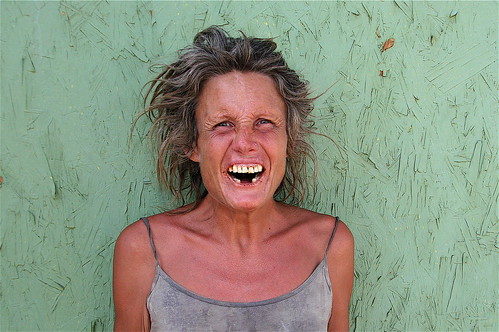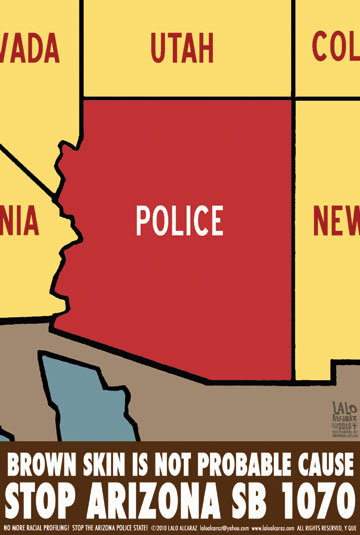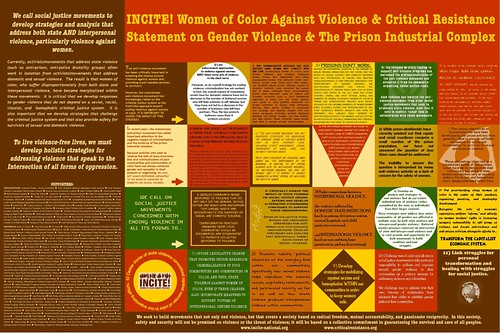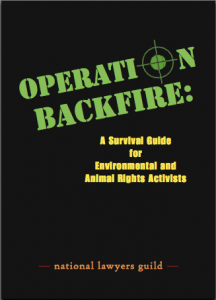At Movements For Change, an event in honor of Kiyoshi Kuromiya on June 10th in Philadelphia, student activist Che Gossett incited a room of sleep-deprived AIDS activists to shouts and tears, reminding us why we are doing this work and inspiring us toward new ways of doing it. The event was hosted by longtime activist Chris Bartlett at the Church of St. Luke and The Epiphany, where ACT UP Philadelphia meets each Monday night at 6pm, and strategized for the future while remembering Kiyoshi, a beloved member of ACT UP who died 10 years ago.
“Kiyoshi believed in intersectionality long before that was a term people used,” Chris said in his opening remarks. “He brought what he learned from the Civil Rights, Gay Liberation and other movements to all of the work he did, and wherever people struggled for human rights and dignity, he was there.”
Che generously shared the text of their talk with us here. Enjoy!
“The white middle-class outlook of the earlier [homophile] groups, which thought that everything in America would be fine if people only treated homosexuals better, wasn’t what we were all about…We wanted to stand with the poor, with women, with people of color, with the antiwar people, to bring the whole corrupt thing down.”[1] Kiyoshi Kuromiya
This quote, especially the call to stand with the poor, women, people of color, anti-war people and for a radical alternative is what, in my understanding, animated Kiyoshi’s life. To me, it represents the core of his legacy and stands as an imperative for discussions of the future.
My talk is supposed to be about the future of gay rights, but how do we talk about a future that, as defined by homo-normative groups and political formations like the HRC [Human Rights Campaign], neither centers nor sometimes even includes those categories Kiyoshi mentions — women (trans and non trans), the poor and people of color? How can we hold a mirror up to a future in which we are not reflected? How is it that we, as queer and transgender people of color are evacuated and disappeared from a future we helped to create?
The Lawrence v. Texas legal decision that struck down sodomy laws has been heralded by gay rights groups, yet it is haunted by the racial violence of its past — the legal basis for the police invasion of Lawrence’s apartment was not “consensual sodomy,” but a false report of a weapons disturbance — the Harris County police dispatcher was called and told, “There’s a nigger going crazy with a gun.”[2] How is it that this racialized past now exists as a sign of a post-racial queer future? In which gay rights are the new civil rights, and the civil rights battles of the 60s have been won? How did we move from gay and trans liberation to queer neoliberalism? From gay anti-capitalism to the depoliticized neoliberal gay market niche? How did we get from the gay anti-imperialism of the Gay Liberation Front, the Philadelphia chapter of which Kiyoshi and Basil O’Brien created in May of 1970[3], to homonationalism — the marriage and military rhetoric — of today? Why, instead of fighting US imperialism, and standing in solidarity with anti-occupation struggles and against political repression, such as the recent Israeli military attack on the Gaza aid flotillas — are queers rushing to join wars rather than protest police and state violence?
In light of this political context, it’s all the more imperative that Kiyoshi’s legacy and the force of the quote be held out as a beacon with which to guide our collective, empowered and self-determined queer and transgender liberationist and feminist futures.
Kiyoshi was born in prison — an internment camp — in 1943, and he never stopped trying to “get free.” For most queer and transgender people of color, prison and police are a defining feature of reality. For many low income, no-income and houseless, queer and trans people of color, the distance between prisons and pride parades is not a chasm but instead, overlapping terrain. This is the terrain upon which prisoner justice, trans justice and abolitionist organizations — Institute for Community Justice, Transforming Justice, Critical Resistance, Hearts on a Wire and Prison Health News — operate in struggle. This is the political terrain, the ground on which ACT UP Philadelphia launched a campaign to decriminalize condoms in Philly jails, took over the BETAK nursing home so that people living with AIDS could have residential space, started an extra-legal needle exchange, and it’s the ground where ACT UP continues their fight against the criminalization and stigmatization of HIV/AIDS. This ground — St. Luke’s Church, is sacred ground, not in a religious sense, but in an activist sense, in a loss and mourning sense, in a memory sense and in a strength and hope sense.
The criminalization of HIV/AIDS was not limited to Reagan’s neoliberal regime, where the President’s Commission on HIV/AIDS funded only those states with criminal disclosure laws, but is happening presently, through the prosecution of black gay men as pathogenic and bio-terroristic threats, ranging from Gregory Smith to Daniel Allen. In November of 2009, Daniel Allen, a black gay Michigan resident, was charged with “bio-terrorism” for the “use of a harmful biological device,” his own (non-HIV-transmissible) saliva.[4] Segregation of incarcerated HIV positive people continues today, legally, in the South in states such as Alabama — the same state that is sending incarcerated people to clean up the BP oil spill[5] — and in Mississippi.[6] The stigmatization of HIV positive incarcerated people, many queer and transgender and of color, is not a new feature of the carceral apparatus, but only a current instance of a long and sordid historical pattern that dates back not only to 1974 when lesbians and gays (and those presumed to be) incarcerated in Florida’s Polk County Jail were segregated from the general population and made to wear pink bracelets, but also to the violence of the Holocaust and the Nazi pink triangle.[7] Reagan’s endorsement of HIV disclosure penalization statutes coincided with his allegiance to the continuing racialized “War on Drugs,” which emerged during the Nixon administration and extended throughout the Reagan and later Clinton presidency as where we get the “Three Strikes” law. The growth of the prison industrial complex, the assemblage of laws criminalizing HIV and addiction, all overlapped with and was underpinned by neoliberal economic policy in the 1980s and 90s.
Yet in the 70s, radical queer organizations organized in prison while being supported on the outside. In 1977, the George Jackson Brigade at Walla Walla prison founded a group that condemned sexual violence against gays. At New Jersey’s Rahway State Prison, the “Gayworld Organization” was formed, and the “Self-Help Alliance Group” (SHAG) was formed at Angola prison in 1984.[8]
This history of this overlapping and cross-movement participation traces back to the Black Panthers’ Revolutionary Peoples’ Convention held at Temple University in 1970. The convention represented a convergence of movements, for gay liberation, women’s liberation and third world and people of color liberation, that are usually seen as separate. A week before the convention, Philadelphia police, led by commissioner Frank Rizzo, raided the offices of the Black Panther Party and publicly forced several Panthers to strip naked at gunpoint, to be photographed by the Philadelphia Inquirer. “Imagine the big Black Panthers with their pants down”[9] Rizzo was quoted as saying — and to me, what Roland Barthes calls the “punctum”[10] of the photograph, or the part that pierces, is that in it, and in their act of police violence, the psychic humiliation of slavery and the auction block resurfaces in the image of the stripped black body.
Yet even in the face of this repression, 10,000 to 15,000 people attended the convention. Radical queer organizations from across the nation, inspired by Huey P. Newton’s August 21st “Letter to the Revolutionary Brothers and Sisters about the Women’s and Gay Liberation Movement,” published in the Black Panther newspaper, attended. Ortez Alderson, a gay black man and leader in the Chicago Gay Liberation Front and Third World Gay Revolutionaries drafted the “Working Paper for the Revolutionary People’s Constitutional Convention,” which outlined a radical anti-racist and anti-homophobic philosophy. Kiyoshi Kuromiya spoke at Temple University’s McGonigle Hall representing the “Male Homosexual Workshop.”[11] Afeni Shakur spoke to a workshop run by the Radical Lesbians. Trans justice activist Sylvia Rivera participated and met with Huey P. Newton. Inspired by gay liberationist activism, two London School of Economics students who attended and likely saw Kiyoshi speak, went back to London and started their own Gay Liberation Front. (I’m currently researching overlap and tension between the London GLF and the British Black Panthers — one member was the radical black feminist and squatter activist Olive Morris). Following the People’s Convention, Ortez Alderson was arrested for breaking into an Illinois draft board and was incarcerated for a year, first at Peoria County Jail for three months, and then he was transferred to a prison in Ashland County, Kentucky. While imprisoned in Kentucky, Alderson and three other queer men of color attempted to form a gay liberation chapter. In a 1972 interview with Motive Magazine titled “On Being Black, Gay and In Prison: There is No Humanity,” Alderson recounted his experience and activism inside:
What I’m trying to relate is the experience of how it was for me as a black and as a gay man to be within the jail system of America…The confrontation came on Gay Pride Day, June 28th, because we wanted to have a Gay Day celebration in prison. The prison officials said we could not have this celebration. At this point, we got up a petition attacking the institution’s discrimination against homosexuals. Craig, Green, Davis and myself were immediately arrested by the goon squad and put in the hole..[12]
Alderson would go on to become a central figure in both NYC[13] and Chicago ACT UP chapters.
I think one crucial dimension of the struggle to disrupt and heal from the historical trauma and violence of COINTELPRO, the FBI war on the black liberation movement — the MOVE bombing of 1985 and police raids targeting Revolutionary Action Movement in the 60s — and the government surveillance and infiltration of national queer organizations such as the Gay Activist Alliance, Gay Liberation Front and more recently ACT UP Philadelphia, the dismantling of welfare and the rise of the prison industrial complex, the criminalization of HIV/AIDS, institutionalized transphobia, racism, sexism — is to, as the movie and the principle “Sankofa,” suggests — “go back and fetch it” — to remember our history, our struggle, our survival, our fierce and fabulous power. Sankofa is an Akan word, often pictured as a bird with its head stretched backwards, and symbolizes a return to the past as a way to be self-determined and whole in the future. What happens when your past has been denied, suppressed and disappeared in history books and in academic institutions by those who operate as what Gramsci called “experts in legitimation”? Kiyoshi’s legacy and the intersectional nature of his involvement in civil rights, black power and queer liberation movements is a direct refutation of that violence.
Cornel West often talks about the etymology of the word human, and the Latin word “humando,” which means “burying.”[14] Sitting amongst Kiyoshi’s life work collected in over 50 boxes in the William Way Center, I felt an overwhelming combination of humanity and humility — my own humanity and humility in the face of Kiyoshi’s life work, and the force of his enduring humanity and courageous humility. That is what I feel now in this room of people here to honor him, it’s what I feel in the sense of collective possibility that emerges when community members come together for radical change. Sitting in that room, surround by artifacts — symbols and representations, Kiyoshi’s pictures and files — his presence was substantive, his historical importance for queer and trans people of color’s history, is indelible, striking and symbolic — just like the lighting bolt and clap of thunder that cut through the sky when he passed.[15] What humanity and what humility! I am proud to say how much he meant to me, even though I never physically met him. His presence is as real as ever, and I want to personally thank him for all of his untiring work, to thank those here who knew him in life and cared for him towards the time of his death, to thank those who carry on Kiyoshi’s legacy, to thank those who fight to open up spaces and horizons of radical futurity we can all be a part of.
[1] Highleyman, L. (2007, May 4). “Who Was Kiyoshi Kuromiya?”. Seattle Gay News . Seattle, Washington, United States of America., p. 30[2] Eng, D. L. (2010). The Feeling of Kinship: Queer Liberalism and the Racialization of Intimacy. Durham, NC: Duke University Press., p. 36
[3] Stein, M. (2004). City of Brotherly and Sisterly Loves. Philadelphia: Temple University Press., p.316
[4] Heywood, T. A. (2009, November 17). “HIV-as-terrorism case could make legal waves”. The Michigan Messenger .
[5] Ferrara, D. (2010, May 29). Prisoners hired in oil relief efforts, trained for hazardous materials work. Retrieved June 9, 2010, from AL.com: http://blog.al.com/live/2010/
[6] ACLU. (2010). Sentenced to Stigma. Washington, DC: ACLU., p.10
[7] Welch, M. (2005). Ironies of Imprisonment. Thousand Oaks, CA: SAGE., p. 65
[8] Kunzel, R. (2008). Criminal Intimacy. Chicago, IL: University of Chicago Press., p. 122
[9] Hevesi, D. (1991, July 17). Frank Rizzo of Philadelphia Dies at 70; A ‘Hero’ and ‘Villain’. The New York Times , pp. pgs. 1-2.
[10] Barthes, R. (1980). Camera Lucida. New York City: Hill and Wang., p. 26
[11] Teal, D. (1995). The Gay Militants/How Gay Liberation Began in America, 1969-1971. New York City: St. Martin’s Press., p. 171
[12] Alderson, O. (1972). “On Being Black and Gay In Prison: There is No Humanity”. Motive Magazine.
[13] Thanks to Mark Harrington for informing me of Ortez Alderson’s participation in ACT UP NYC on June 10th at the “Remembering Kiyoshi Kuromiya” gathering at St. Luke’s Church in Philadelphia PA.
[14] West, C. (2000). The Cornel West Reader. New York City: Basic Books., p. 551
[15] Sosa, A. (2010, June 11). Remembering Kiyoshi Kuromiya, Kiyoshi Video. (M. Seaman, Producer, & Mighty Head Entertainment/Philadelphia Fight) Retrieved June 12, 2010, from Philadelphia FIGHT: http://www.fight.org/























No comments:
Post a Comment